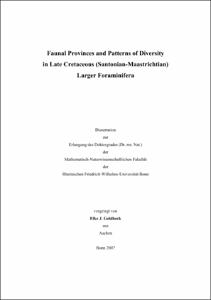Goldbeck, Elke J.: Faunal Provinces and Patterns of Diversity in Late Cretaceous (Santonian-Maastrichtian) Larger Foraminifera. - Bonn, 2008. - Dissertation, Rheinische Friedrich-Wilhelms-Universität Bonn.
Online-Ausgabe in bonndoc: https://nbn-resolving.org/urn:nbn:de:hbz:5N-12940
Online-Ausgabe in bonndoc: https://nbn-resolving.org/urn:nbn:de:hbz:5N-12940
@phdthesis{handle:20.500.11811/3557,
urn: https://nbn-resolving.org/urn:nbn:de:hbz:5N-12940,
author = {{Elke J. Goldbeck}},
title = {Faunal Provinces and Patterns of Diversity in Late Cretaceous (Santonian-Maastrichtian) Larger Foraminifera},
school = {Rheinische Friedrich-Wilhelms-Universität Bonn},
year = 2008,
note = {A detailed biogeographical analysis of the global distribution of 25 different genera of larger symbiont-bearing foraminifera from the Late Cretaceous reveals that they exhibit distinct patterns. On a generic level, the distribution is divisible into regional, superregional and global categories. Four Faunal Provinces (FP) were established: 1) Caribbean FP, 2) Asiatic FP, 3a) European Tethys, and 3b) African Tethys. The precise classification of the latter two Faunal Provinces into subprovinces requires further detailed studies. The European Tethys can be divided into western and eastern subprovinces. The analysis of generic diversity shows a maximal value in the western part of the Southern European Tethys. A second peak, with a minor value, is situated in the eastern part. Maximum diversity appears to result from the large available area (shallow shelf regions) and corresponding physical and biological factors (high temperature, high insolation, high mutation rate). The prevailing sea surface currents are the main influence on the distribution of the larger foraminifera, as well as on the extent of the bioprovinces. The center of diversity in the Late Cretaceous European Tethys is comparable in its characteristics with the modern “hotspot” of marine diversity, which is situated in the Indopacific Ocean. Therefore, it is possible to speak of a displacement of the “hotspot” from the European Area of the Tethys in the Late Cretaceous to the Indopacific region in modern oceans. The displacement is the result of paleogeographic changes that occurred since the Late Cretaceous.},
url = {https://hdl.handle.net/20.500.11811/3557}
}
urn: https://nbn-resolving.org/urn:nbn:de:hbz:5N-12940,
author = {{Elke J. Goldbeck}},
title = {Faunal Provinces and Patterns of Diversity in Late Cretaceous (Santonian-Maastrichtian) Larger Foraminifera},
school = {Rheinische Friedrich-Wilhelms-Universität Bonn},
year = 2008,
note = {A detailed biogeographical analysis of the global distribution of 25 different genera of larger symbiont-bearing foraminifera from the Late Cretaceous reveals that they exhibit distinct patterns. On a generic level, the distribution is divisible into regional, superregional and global categories. Four Faunal Provinces (FP) were established: 1) Caribbean FP, 2) Asiatic FP, 3a) European Tethys, and 3b) African Tethys. The precise classification of the latter two Faunal Provinces into subprovinces requires further detailed studies. The European Tethys can be divided into western and eastern subprovinces. The analysis of generic diversity shows a maximal value in the western part of the Southern European Tethys. A second peak, with a minor value, is situated in the eastern part. Maximum diversity appears to result from the large available area (shallow shelf regions) and corresponding physical and biological factors (high temperature, high insolation, high mutation rate). The prevailing sea surface currents are the main influence on the distribution of the larger foraminifera, as well as on the extent of the bioprovinces. The center of diversity in the Late Cretaceous European Tethys is comparable in its characteristics with the modern “hotspot” of marine diversity, which is situated in the Indopacific Ocean. Therefore, it is possible to speak of a displacement of the “hotspot” from the European Area of the Tethys in the Late Cretaceous to the Indopacific region in modern oceans. The displacement is the result of paleogeographic changes that occurred since the Late Cretaceous.},
url = {https://hdl.handle.net/20.500.11811/3557}
}






